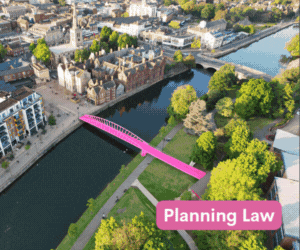Deploying ‘ADR’ in Planning & Compensation contexts
John Pugh-Smith looks at how these aspects of alternative dispute resolution (ADR) can now be made to work and at different stages of a dispute. Put another way, the “A” in ADR is not just “alternative” but also “adaptable”, “agile” and “accessible”.
- Details
Introduction
Whilst Mediation has become central to the English civil justice system (and has become mandatory in some cases) it is still not presently really used in this country’s planning system. Equally, while both Mediation and Early Neutral Evaluation (ENE/NE) has been utilised in the compensation field their deployment tends still to been more reactive than proactive.
The Civil Litigation Context
While the “sea change” is attributed to the case of Churchill v Merthyr Tydfil CBC [2023] EWCA Civ 1416 (“Churchill”) overruling the earlier Halsey decision, allowing courts to mandate that parties explore ADR, it has been the specific CPR amendments last October for the cultural climate to begin changing meaningfully. By way of an overview the following points need to be borne in mind.
First, is the significant change to the scope of CPR 1. Here, the overriding objective of “enabling the court to deal with cases justly and at proportionate cost” is now expanded to include “using and promoting ADR”.
Secondly, are the amendments to court’s management powers under CPR 3.1(2)(o) and (p) . These now read:
“(o) order the parties to participate in ADR;
(p) take any other step or make any other order for the purpose of managing the case and furthering the overriding objective, including hearing an Early Neutral Evaluation with the aim of helping the parties settle the case.”
Thirdly, is the amendment to the costs provisions of CPR 44 (which includes how the litigation has been conducted by the parties). The following is added:
“whether a party failed to comply with an order for alternative dispute resolution, or unreasonably failed to engage in alternative dispute resolution proposed by another party.”
Fourthly, account also needs to be taken of pre-action protocol requirements, both current and in train. Indeed, in an area where ADR had not previously been seriously considered, the November 2024 Civil Justice Council’s Phase 2 final report on pre-action protocols commented that there are “some judicial review cases where ADR will be appropriate and the court can make case management directions to enable it to happen”.
So, the fundamental change for general litigation (and practitioner expectation) should now lie in the ability of the Judiciary to mobilise ADR (especially mediation) during the life of any case. This is in contrast with the pressure to mediate merely being generated by the likelihood that a case will reach trial, and, that costs sanctions might be imposed by a judge retrospectively for unreasonably refusing to mediate.
Constructive Options
In the context of any dispute or potential dispute , putting the “A” for “Accessibility” and “Agility” into ADR requires both the parties as well as the professionals to understand what is available.
Putting the “A” for “Adaptability” into ADR requires the ability to carve out aspects of a dispute to suit the form of ADR most suitable (e.g. on technical matters) as well as in the interests of commercial expediency. Indeed, a “Swiss army knife” hybrid approach allows the form of the ADR needed at different stages to be deployed.
“Mediation” at its most pure form is simply facilitated negotiation. This can take place either through neutral chairing or the more formalised process. In this latter context, and, as usually contemplated by the Courts by the stage a case reaches its judicial case management, it is the process of confidential, assisted negotiation guided by a trained, independent professional (the mediator). It will give the parties in dispute and their representatives an opportunity to agree jointly the details of any settlement after an examination of their respective needs and of the options and possibilities for resolution. While the mediator does not make a determination of the issues in dispute or impose a settlement on the parties, their aims are to assist the parties to identify and agree a settlement that is responsive to their needs and with which they commit to comply.
The “ENE/NE” process in its simplest form involves a suitably qualified, experienced and independent third party (“the evaluator”) considering the merits of a case and expressing their view, orally and/or in writing, with the aim of assisting the parties to achieve a consensual resolution or limitation of the contentious issues. The process ensures that negotiations are really and truly conducted in the litigation context, ensuring that the underlying case merits are kept in mind throughout, alongside a realistic assessment of the likely risks and costs, financial or otherwise, of walking away from the negotiating table.
Further, there is the potential in complex muti-aspect or highly technical cases, to combine the skill of the mediator with the expertise of an independent expert or evaluator. The mediator can have the independent expert attend for their support on technical matters; and be made available for confidential evaluative discussions with the parties, either jointly or privately, at the mediator’s direction. The parties remain in control of their own decisions and normal mediation rules apply, but core issues in dispute can be better ‘hot tubbed’ between professionals, in confidence, rather than in Court.
This approach can be used at any stage and has the potential to readily unlock technical problems and prevent a new line of argument opening, even with a NE determination which is still disagreed, too.
Plan-making and Development Management
The potential for mediation to contribute to the planning process is not new. It has been recognised for many years, including in particular:
- the 2006 Barker Review of Land Use Planning Final Report which suggested that “DCLG should establish a planning mediation service to act as an alternative dispute resolution mechanism with the planning system”;
- the Government’s 2009 response to the Killian-Pretty Report, which urged investigation of the use of ADR at all stages of the planning process;
- the 2010 Report commissioned by the National Planning Forum and the Planning Inspectorate, ‘Mediation in Planning’4 by Leonora Rozee OBE (Project Chair and then PINS Deputy Chief Executive and Director of Policy) and Kay Powell (NPF appointed Secretary), which considered the question in detail “the Rozee Report”) ; and
- the National Planning Forum’s 2011 ‘Mediation in Planning: A short guide’ which was endorsed by former Minister for Planning, Bob Neill MP, and converted many of the points made by the Rozee Report into guidance.
The Rozee Report resulted from a detailed exploration of the potential role of mediation in the planning system, conducted case studies, and ran a steering group of experienced planning professionals. It advocated powerfully for mediation in planning, drawing the following conclusions which are still equally applicable:
- Mediation can assist in a wide range of planning contexts, including development planning and master planning, development management, pre- application on major infrastructure development, section 106 negotiations and enforcement;
- The potential advantages of mediation in the planning system include:
- time and cost savings, including to the public purse, fewer appeals and swifter, more cost effective decision-making;
- building capacity for dialogue between councils and stakeholders and a more collaborative and locally based approach supporting more holistic planning, all of which can boost public confidence in government);
- more acceptable and sustainable development proposals;
- higher levels of satisfaction amongst users of the planning system;
- the capacity to accommodate multiple parties in complex cases and explore of a wide range of issues in a non-confrontational manner;
- the retention of local issues at local level and a form of ‘participatory democracy’ which feeds into decisions of elected representatives (‘representative democracy’).
Accordingly, when and how should it be deployed, either in its most benign (e.g. the appointment of a neutral chair) or as a more structured process through a jointly appointed mediator. Again, this is a well-trodden path, as the Guide explained nearly 15 years ago:
“Mediation is a flexible tool that can provide potential benefits across a wide range of planning matters and issues, including: development plan documents; planning applications; planning obligations and infrastructure cost negotiations; pre- application consultation; design and layout; conditions; neighbour objection; enforcement; compulsory purchase issues and compensation; and community right to build.”[1]
The Guide also contained additional detail on the earlier successful case studies and two further examples – concerning site selection for a proposed school, and pre- application engagement in relation to major residential development – in which mediation was used successfully.
Specifically, in the plan-making context, one concerned a dispute over a site allocation during the local plan preparation process. Mediation between the LPA and the site owner led to a change in policy and an agreed site plan, and results not only in a more robust set of policies but also time and cost savings in the local plan process. The other concerned a retail developer objects to a proposed local plan mixed use allocation. Mediation involving LPA officers, the developer, representatives and consultants facilitate a more frank dialogue than would be possible at a public hearing or inquiry and leads to agreement on revised policy and withdrawal of the objection. It also leads indirectly to potential new business for the town.
A further illustrative example concerns strategic housing land assembly for an urban extension involving various landowners. Appointing co-mediators (a chartered surveyor and this planning counsel), the LPA brough the landowners together who, eventually, agreed Heads of Terms after an extended period of facilitated negotiation.
Because mediation is conducted on a confidential basis, good news stories have tended to be anecdotal. From the experience of PEBA fellow mediators, development management examples have included where housing development on an inner city brownfield site had stalled due to a dispute over on-site affordable housing. At the mediation viability issues were explored, modifications to the section 106 agreement are approved by councillors at committee.
Another example was where the LPA resolved to delegate authority to officers to grant planning permission for a large mixed use scheme subject to amongst other things a section 106 agreement which is appended to the report to committee. A dispute arises as to the provisions in that agreement relating to the construction of a ring road, a collaboration agreement and step in rights for the council to construct the ring road if not progressed by the developer. After discussions fail, mediation settled the dispute and a revised section 106 agreement was agreed such that planning permission can be granted.
Although, sadly, or systemic reasons the MHCLG/PINS Enforcement ‘Pathfinder’ initiative in summer 2021failed to reduce the appeals backlog there was renewed recognition of the important role in producing batter outcomes. Actual examples have included where a formal mediation overcame a breakdown in communication at the heart of a long- running and failed enforcement case; agreement for compliance over a realistic timescale delivers an outcome that is satisfactory to all sides. Another, was where an enforcement notice required total demolition of a new house built larger than permitted. At mediation the parties agreed a set of design principles for reductions in size and a fresh planning application, saving substantial time and expense in both the enforcement and development management contexts.
Furthermore, in most of the above contexts, an evaluative approach by the mediator has bene necessary. Accordingly, one wonders whether the deployment of ENE/NE might have helped lead to quicker outcomes?
High Court judicial review
With the CPR rule amendments the need to consider suitability for ADR does arise in the Planning Court. While the work undertaken by and through PEBA’s ADR Working Group has confirmed that it will continue to be mainly, though not exclusively, in the context of planning judicial reviews where ADR (both mediation and NE) can be most successfully deployed.
For now, known cases where mediation has worked have included the construction of an urgently required medical facility is delayed by judicial review proceedings concerning heritage issues. Following mediation an amended design was agreed and a section 73 consent issued, allowing construction to commence. Another was where there was a judicial review by the local community of the grant of permission for an urban extension. The claim is withdrawn following agreement that a section 96A application will address local concerns by amending the scheme. The third concerned a long-running enforcement case involving the local community and including appeals over a number of years, culminating in expensive High Court proceedings. Eventually, proceedings were stayed whilst a solution satisfactory to all parties is put to the LPA planning committee, but not before large sums in costs and other private and public resources are expended. Early mediation could have avoided most of this expenditure.
Compulsory acquisition and compensation
In contrast, ADR has had a more positive though still muted reception from specialist practitioners. Indeed, as far back as October 2018 the Compulsory Purchase Association (CPA) has given formal recognition through its Land Compensation Claims Protocol.[2]
The Protocol applies to any claim for compensation made by a claimant to a compensating authority that would, in the absence of agreement between the parties, involve a reference to the Upper Tribunal (Lands Chamber) under Part 5 of the Upper Tribunal (Lands Chamber) Procedure Rules 2010 (as amended) (“Rules”)1. It does not apply to any matter that would be referred under Part 5 but which does not involve a Compensation Claim.
As to ADR, the current Protocol advises as follows:
5.1. This protocol does not attempt to advise parties to a compensation dispute how claims might be settled or issues resolved without litigation in the Tribunal. However, it does require that in all cases parties should give due consideration to any opportunity to avoid a Reference or narrow the issues between them by using alternative dispute resolution (“ADR”).
5.2. The use of ADR, including mediation, can provide a less formal and more cost effective method of resolving compensation disputes and the Tribunal seeks to encourage its use in appropriate cases. The Tribunal will bring to the attention of the parties the availability of any appropriate alternative procedure for resolution and, if the parties wish, may facilitate its use (for example by granting a stay of proceedings). The claimant and the compensating authority should also be aware that the Tribunal may consider whether a party has unreasonably refused to consider ADR when deciding what costs order to make, even when the refusing party is otherwise successful.
5.3. The Tribunal’s Explanatory Leaflet for Compulsory Purchase Compensation, Land Compensation Disputes and Other References (T604) 10 provides brief information on the use of ADR in compensation cases, focusing on mediation. Information on all forms of ADR is provided by the Royal Institution of Chartered Surveyors.11 In most cases the parties should consider taking professional advice about the use of ADR.
Endorsing guidance is now to be found in the recent MHCLG publication “ Guidance on the Compulsory Purchase Process (Jan. 2025)[3] . At paragraph 18 it advises:
“Can alternative dispute resolution techniques be used to address concerns about a compulsory purchase order?
18.1 In the interests of speed and fostering good will, acquiring authorities are urged to consider offering those with concerns about a compulsory purchase order full access to alternative dispute resolution techniques. These should involve a suitably qualified independent third party and should be available wherever appropriate throughout the whole of the compulsory purchase process, from the planning and preparation stage to agreeing the compensation payable for the acquired properties.
18.2 The use of alternative dispute resolution techniques can save time and money for both parties, while its relative speed and informality may also help to reduce the stress which the process inevitably places on those whose properties are affected. 19 For example, mediation might help to clarify concerns relating to the principle of compulsorily acquiring the land, while other techniques such as early neutral evaluation might help to relieve worries at an early stage about the potential level of compensation eventually payable if the order were to be confirmed.”
From personal experience, my mediator examples have concerned compensation claims at the pre-determination stage, usually a few weeks before the Tribunal hearing where minds are focused more solution. Here, the success rate has been high, albeit the length of the mediation day somewhat lengthy. Others have dealt with more granular matters including the content of certificates of appropriate development and the form of highway accommodation works requiring the re-arrangement of HGV access to an international transport depot.
Concluding thoughts
Contemporary land-use dispute management, like stemming climate change through moves towards “net zero”, are as much about changes in habits and practices as well as what can be realistically achieved. It is also about (re-)education and understanding. Because ADR is conducted on a confidential basis, too little publicity can or is being given to its successful deployment at present. Nonetheless, there are growing “good news” stories as well as reported cases which should encourage even the more conservative members of the legal profession to soften their historic stance, and, for the newer arrivals more willingly to embrace the deployment ADR. Here’s hoping … !
JOHN PUGH-SMITH FCIArb of 39 Essex Chambers is an experienced mediator, arbitrator and dispute ‘neutral’. He is on the panels of the RICS President’s appointments for non-rent review references and the Association of Northern Mediators. He is a long-serving member of the Bar Council’s ADR Panel. He has been and remains extensively involved in various initiatives to use ADR particularly to resolve a range of public sector issues.
Please note that this article has been informed and assisted by the support, encouragement and assistance of working with his mediator colleagues on the PEBA ADR Working Group (Craig Howell-Williams KC, Josef Cannon KC, Celina Colquhoun and Hary Spurr), the CPA’s David Baker FRICS FCILT MCIArb, and, his 39 Essex co-podcaster, Juan Lopez. Their complementary audio resource to this article is available either through this link: https://www.39essex.com/information-hub/podcasts , or, through
The Bar Council’s own guidance on Neutral Evaluation can be found here: https://www.barcouncilethics.co.uk/wp-content/uploads/2024/11/Bar-Council-Guide-to-NE-final.pdf
[1] ‘Mediation in Planning: A short guide’, p.3 (para. (i)
[2] https://compulsorypurchaseassociation.org/land-compensation-claims-protocol.html
[3] https://assets.publishing.service.gov.uk/media/67eac2220678ace40a7f27b8/CPO_Guidance_Update_January_2025.pdf
Senior Lawyer - Contracts & Commercial
Lawyer - Property
Contracts & Procurement Lawyer
Trust Solicitor (Employment & Contract Law)
Locums
Poll









































